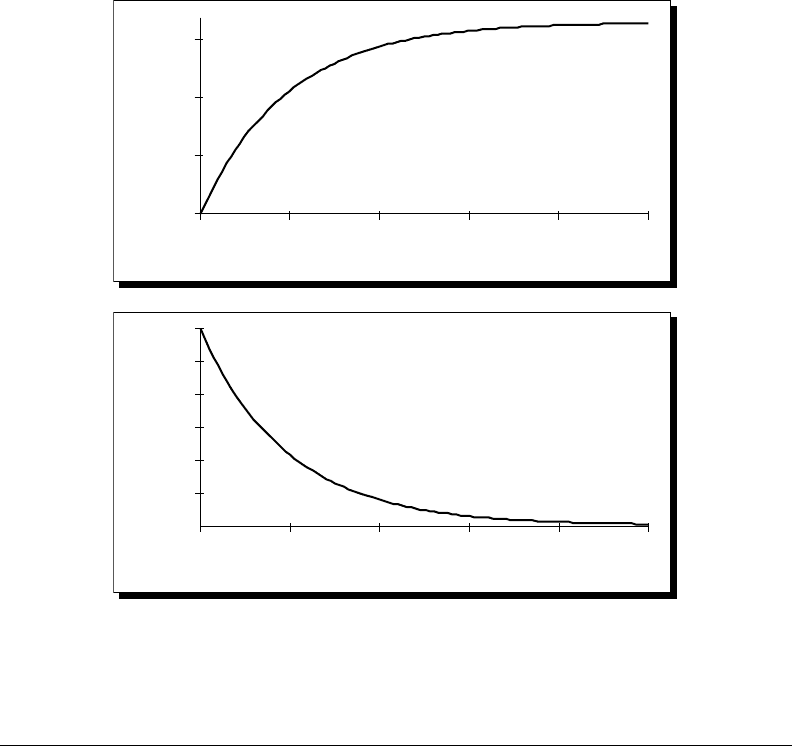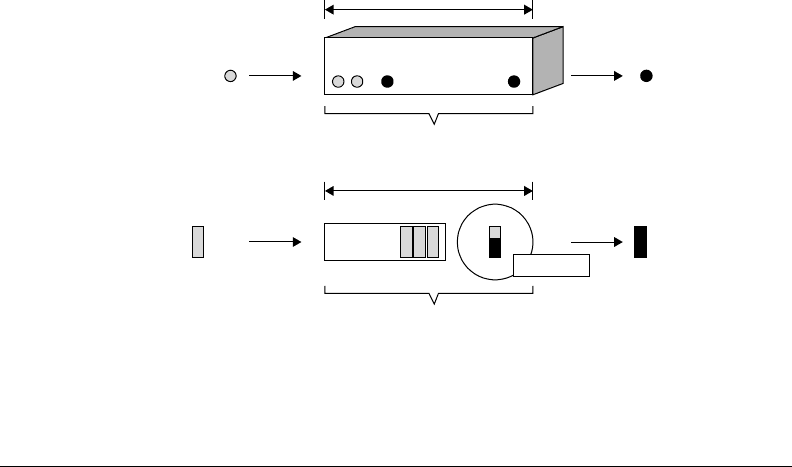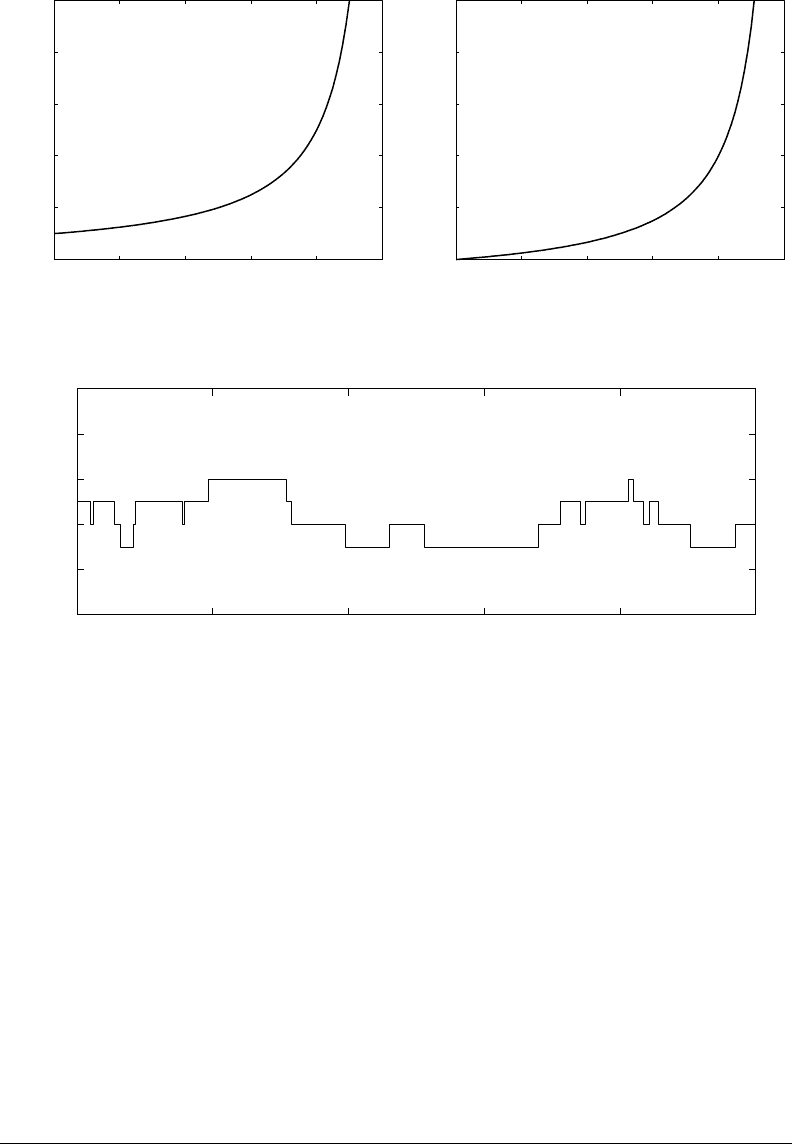Fishwick P.A. (editor) Handbook of Dynamic System Modeling
Подождите немного. Документ загружается.

33-20 Handbook of Dynamic System Modeling
or Vensim is used, the modeller draws the diagram on screen by selecting appropriate icons from a palette.
Hence, the software knows which objects are levels which are rates and which are parameters. In a more
complex model there might also be objects on the diagram to represent the delay is of different kinds.
Since the software knows which objects are levels and which are rates it can determine the level equations.
In our example there is only one level, customers, and the value that it takes at any time depends on its
previous value and the difference between the incoming rate and the outgoing rate. Most system dynamics
models are time slicing; that is, they move simulated time forwards in equal steps. This time increment is
usually known as dt. Hence the software can determine that the level equation for customers will take the
following form:
new customer level = old customer level + (new customer rate - lost
customer rate)*dt
where this assumes that the new customer rate and lost customer rate are both constant over the interval
dt. In essence, the level equations are determined by the “physics” of the system, in that matter is neither
created nor destroyed, but is conserved.
However, the software cannot determine the rate equations, for these depend on the policies chosen
by the company and also by factors outside of their control. For example, they may have analyzed the
customer losses over the last few years and discovered a regular pattern in which they lose a proportion of
their customers each month. Similarly, they may represent the effectiveness of an advertising campaign by
a constant which indicates the amount that should be spent to gain a new customer. Unless the model is
provided with this information, the simulation software has no way of knowing what these values are, nor
can it know what form the relationships take. Hence, in all system dynamics software, the user must define
each rate equation and the links between the system parameters and the various equations in the model.
Given what is said above, a possible set of rate equations might be as follows:
AdSpendRate = MIN(IF(CustomerTarget-Customers > 0,
50*(CustomerTarget-Customers), 0), MaxAdSpend)
LostCustomerRate = Customers*LossProportion
NewCustomerRate = AdSpendRate/AdEffectiveness
The first rate equation represents a policy of spending £50 per missing customer, where the number of
missing customers is the difference between the customer target and the actual current number of customs.
Since it is possible for the number of customers to be higher than the target, the calculation is wrapped in
an if statement that checks whether or not the actual number of customers is less than the target. If the
number of customers is greater than the target then it makes no sense at all to spend money on advertising
and hence the equation returns the value of zero. The other two rate equations are self-explanatory.
We can now run a simulation using this model if we provide values for the parameters and an initial
value for the number of customers. Suppose that the initial number of customers is 5000, the target
number of customers is 6000, the proportion of customers lost each period is 0.05, and the advertising
effectiveness takes the value of 45. Note that this value of 45 compares with a unit expenditure per missing
customer 50, implying that advertising is not 100% effective. Running a simulation for 100 time units,
where a time unit might be a week or a month, leads to the behavior shown in the graphs of Figure 33.9.
The bottom graph shows the effect of fixing MaxAdSpend at 10,000—they continually lose customers. The
top graph shows that raising this to 12,000 means that they will gradually approach their target. Hence, by
varying the parameter values the managers can experiment with different policies to see what effect they
may have. Similarly, they could take the causal loop diagram shown in Figure 33.7 and develop a set of
system dynamics equations to represent it. If they wished they could then run further simulations to see
what effect different options might have given the slightly more complicated representation of this second
model.

Dynamic Modeling in Management Science 33-21
Time
Customers
0 20406080100
5,000
5,100
5,200
5,300
Customers
4,500
4,600
4,700
4,800
4,900
5,000
Max Ad Spend 12,000
Max Ad Spend 10,000
Time
0 20406080100
FIGURE 33.9 Output from the Powersim model of Figure 33.8.
33.5 Model Validation
In any modeling application it is important to ask whether the model is valid for its intended purpose. Sadly
this seems to be an area that is often neglected by management scientists engaged in simulation modeling,
whether using DES or system dynamics. It is rarely possible to fully validate any model, especially if
the model is to be used to investigate new situations. This is because using a model to investigate new
situations means that any data on which it was built may have to be stretched to represent the situation
being investigated. Even if we are clear that the model is valid for the current situation it may not be valid
for the new one being investigated. Nevertheless, some formal validation is always possible and the various
approaches are discussed in detail in Chapter 12 of Pidd (2004b). Not attempting any model validation is
risky because it may lead to wrong conclusions being drawn and wrong decisions being made.
The simplest form of model validation is often referred to as Black Box validation. In this we run the
model under well-defined conditions and collect output. We select the conditions under which the model
run is to be, as far as possible, identical to conditions that have occurred in the system being simulated.
We then tune the simulation model, that is we modify its values, as appropriate, in an attempt to ensure
that the model output is indistinguishable from the output of the real system. This is called Black Box
validation because we are only concerned with the inputs and outputs of the model and of the system
rather than the internal workings. We should, though, be aware that coincidences do happen and that they
could be several reasons why the model and the real system appear to behave in the same way. We cannot
be sure that this occurs because of the model adequately represents the operation of the real system. If we
wish to assure ourselves on this count, then we must attempt what is often known as White Box validation.

33-22 Handbook of Dynamic System Modeling
A better name for White Box validation would be transparent box validation, since the idea is to look at
the detailed internal workings of the model to see if they adequately represent the operation of the system
being simulated. For example, in simulating a telephone call center we may wish to assure ourselves that
the way that one operator hands over to another at the end of a shift is correctly represented in the model.
This is not a question of looking at the model output but rather at the way the logic has been programmed
into the model. We must, though, notice that even a White Box validation can never be complete because
we may wish, as mentioned above, to simulate situations which as yet do not exist. In such cases we can
only check that the logic of the simulation model is the logic that is expected to hold in the real system.
Sadly, though, the known failings of both Black Box and White Box validation are unlikely to be the
reasons why many management science simulation models are not validated. In many cases they are not
properly validated because the analyst or the client have not allowed enough time for this to be done.
Shortage of time and other resources often leads to corners being cut, and proper validation is often the
victim of this. Fortunately, this may not matter in at least some situations, for it is very unlikely that most
organizations will make significant investments on the basis of small probabilities. That is, they are only
likely to make investments if there is a really significant benefit to be gained. It is possible that even a
partially valid model may be able to demonstrate this.
33.6 Chapter Summary
A core feature of management science, or operational research, is the use of models to aid in decision
making. Modelshelp decision makers and planners to think through the possible consequences of decisions
before taking any action. There are many different modeling approaches used in management science and
the most commonly used dynamic approaches are DES and system dynamics. A DES model captures the
detailed logicalinteractions of the entities that compose the system of interest. In management science, DES
models are usually built using VIMSs, and it is rare for such applications to be programmed from scratch.
To build a system dynamics model we must take a rather different focus. Instead of modeling the detailed
interaction of individual entities we are concerned with the changes in populations of entities. These
are represented in first-order difference equations which may then be used, with a numerical integration
method, to simulate the operation of the system. Contemporary system dynamics in management science
may be qualitative or quantitative and in the former case, causal loop diagrams offer a useful way to
understand how systems operate. Sad to say, though, model validation is clearly very important, it is
probably true that this is not well executed in management science for either DES or system dynamics.
References
Cota, B.A. and Sargent, R.G. (1990) Control flow graphs: a method of model representation for parallel
discrete event simulation. CASE Center Technical Report 9026, CASE Center, Syracuse University.
Coyle, R.G. (1996) System dynamics modelling: a practical approach. Chapman & Hall, London.
Daellenbach, H. and McNickle, D. (2004) Management science: decision-making through systems
thinking. Palgrave-MacMillan, London.
Forrester, J.W. (1961) Industrial dynamics. MIT Press, Cambridge, MA.
Hillier, F.S. and Lieberman, G.J. (2005) Introduction to operations research (8th Ed). McGraw-Hill,
New York.
Hlynka, M. (2004) Queueing theory books. http://www2.uwindsor.ca/∼hlynka/qbook.html
Jackson, M.C. (2003) Systems thinking: creative holism for managers. Wiley, Chichester.
Law, A.M. and Kelton, W.D. (2000) Simulation modeling and analysis (3rd Ed). McGraw-Hill, New York.
Micro Analysis and Design (2005) Micro Saint Sharp simulation software. www.maad.com
Pidd, M. (2003) Tools for thinking: modelling in management science. Wiley, Chichester.
Pidd, M. (2004a) Computer simulation in management science. Wiley, Chichester.
Dynamic Modeling in Management Science 33-23
Pidd, M. (2004b) Simulation worldviews—so what? In: Proceedings of the 2004 Winter Simulation
Conference. R.G. Ingalls, M.D. Rossetti, J.S. Smith, and B.A. Peters, eds. 5–8 December 2004,
Washington Hilton and Towers, Washington, DC.
Richmond, B. and Petersen, S. (1994) Stella II: an introduction to systems thinking. High Performance
Systems Inc., Hanover, NH.
Robinson, S.L. (2004) Simulation: the practice of model development and use. Wiley, Chichester.
Schruben, L. (1983) Simulation modeling with event graphs, Communications of the ACM, 26(11),
957–963.
Senge, P. (1999) The fifth discipline: the art and practice of the learning organization. Random House,
London.
Sterman, J.D. (2000) Business dynamics: systems thinking and modeling for a complex world. Irwin
McGraw-Hill, New York.
Taha, H.A. (2003) Operations research: an introduction (7th Ed). Prentice-Hall, Englewood Cliffs, NJ.
Winter Simulation Conference web site: www.wintersim.org
Wolstenholme, E.F. (1990) System enquiry: a system dynamics approach. Wiley, Chichester.
Zeigler, B.P. (1976) Theory of modelling and simulation. Wiley, New York.
Zimmerman, A. (2004) Petri nets. http://pdv.cs.tu-berlin.de/∼azi/petri.html

34
Modeling and Analysis of
Manufacturing Systems
E. Lefeber
Eindhoven University of Technology
J.E. Rooda
Eindhoven University of Technology
34.1 Introduction ................................................................ 34-1
34.2 Preliminaries ................................................................ 34-2
34.3 Analytical Models for Steady-State Analysis .............. 34-3
Mass Conservation (Throughput)
•
Queueing Relations
(Wip, Flow Time)
34.4 Discrete-Event Models ................................................ 34-7
34.5 Effective Process Times ............................................... 34-8
34.6 Control of Manufacturing Systems: A Framework ... 34-10
34.7 Standard Fluid Model and Extensions ....................... 34-12
A Common Fluid Model
•
An Extended Fluid
Model
•
An Approximation to the Extended Fluid
Model
•
AHybridModel
34.8 Flow Models ................................................................. 34-16
Introduction to Traffic Flow Theory: The LWR Model
•
A Traffic Flow Model for Manufacturing Flow
34.9 Conclusions ................................................................. 34-18
34.1 Introduction
The dynamics of manufacturing systems has been a subject of study for several decades (Forrester, 1961;
Hopp and Spearman, 2000). Over the last years, manufacturing systems have become more and more
complex and therefore a good understanding of their dynamics has become even more important.
The goal of this chapter is to introduce a large variety of models for manufacturing systems. By means
of examples it is illustrated how certain modeling techniques can be used to derive models that can be used
for analysis or control. In addition to references that can be used as a starting point for further inquiry,
recent developments in the modeling, analysis, and control of manufacturing systems are presented.
Since no familiarity with manufacturing systems is assumed, in Section 34.2 some terminology and basic
properties of manufacturing systems are introduced. Section 34.3 provides some analytical modeling
techniques and methods for analyzing steady-state behavior. Section 34.4 is concerned with deriving
discrete-event models, which yield a more detailed insight in the dynamics of a manufacturing system. To
reduce the complexity of discrete-event models, the concept of effective process times (EPTs) is introduced
in Section 34.5, which results in modeling a manufacturing system as a large queueing network. This way
of modeling a manufacturing system is a first step in a larger control framework, which is introduced in
Section 34.6. This control framework makes it possible to study problems of controlling the dynamics
of manufacturing systems by means of the available inputs. An important role in this control framework
is played by approximation models. The most commonly used approximation models are presented in
Section 34.7. Recently, a new class of approximation models has been proposed, which is presented in
Section 34.8. Section 34.9 concludes this chapter.
34-1

34-2 Handbook of Dynamic System Modeling
w (h)
d (lots/h)
w (lots)
w (lots)
d (lots/h)
Factory
level
Machine
level
w (h)
Buffer
t
0
(h)
FIGURE 34.1 Basic quantities for manufacturing systems.
34.2 Preliminaries
First a few basic quantities are introduced as well as the main principles for manufacturing system analysis.
The items produced by a manufacturing system are called lots. Also the words product and job are
commonly used. Other important notions are throughput, flow time, wip, and utilization. These notions
are illustrated in Figure 34.1 at factory and machine level.
Raw process time t
0
of a lot denotes the net time a machine needs to process the lot. This process time
excludes additions such as setup time, breakdown, or other sources that may increase the time a lot
spends in the machine. The raw process time is typically measured in hours or minutes.
Throughput δ denotes the number of lots per unit time that leaves the manufacturing system. At a
machine level, this denotes the number of lots that leave a machine per unit time. At a factory
level it denotes the number of lots that leave the factory per unit time. The unit of throughput is
typically lots/hour.
Flow time ϕ denotes the time a lot is in the manufacturing system. At a factory level this is the time
from the release of the lot into the factory until the finished lot leaves the factory. At a machine
level this is the time from entering the machine (or the buffer in front of the machine) until leaving
the machine. Flow time is typically measured in days, hours, or minutes. Instead of flow time the
words cycle time and throughput time are also commonly used.
Work in process (wip) w denotes the total number of lots in the manufacturing system, i.e., in the factory
or in the machine. Wip is measured in lots.
Utilization u denotes the fraction a machine is not idle. A machine is considered idle if it could start pro-
cessing a new lot. Thus process time as well as downtime, setup time, and preventive maintenance
time all contribute to the utilization. Utilization has no dimension and can never exceed 1.0.
Ideally, a manufacturing system should both have a high throughput and a low flow time or low wip.
Unfortunately, these goals are conflicting (cf. Figure 34.2) and both cannot be met simultaneously. If a
high throughput is required, machines should always be busy. As from time to time disturbances like
machine failures happen, buffers between two consecutive machines are required to make sure that the
second machine can still continue if the first machine fails (or vice versa). Therefore, for a high throughput
many lots are needed in the manufacturing system, i.e., wip needs to be high. As a result, if a new lot
starts in the system it has a large flow time, since all lots that are currently in the system need to be
completed first.

Modeling and Analysis of Manufacturing Systems 34-3
0 0.2 0.4 0.6 0.8 1
0
2
4
6
8
10
Throughput (d )
Wip (w)
0 0.2 0.4 0.6 0.8 1
0
2
4
6
8
10
Throughput (d )
Flow time (w)
FIGURE 34.2 Basic relations between basic quantities for manufacturing systems.
0 5 10 15 20 25
0
2
4
6
8
10
Time
Wip
FIGURE 34.3 A characteristic time-behavior of wip at a workstation.
Conversely, the least possible flow time can be achieved if a lot arrives at a completely empty system and
never has to wait before processing takes place. As a result, the wip level is small. However, for most of the
time machines are not processing, yielding a small throughput.
When trying to control manufacturing systems, a trade-off needs to be made between throughput and
flow time, so the nonlinear (steady-state) relations depicted in Figure 34.2 need to be incorporated in any
reasonable model of manufacturing systems.
A final observation of relevance for modeling manufacturing systems is the nature of the system signals.
In Figure 34.3 a characteristic graph of the wip at a workstation as a function of time is shown. Wip always
takes integer values with arbitrary (nonnegative real) duration. One could consider a manufacturing
system to be a system that takes values from a finite set of states and jumps from one state to the other as
time evolves. This jump from one state to the other is called an event. As we have a countable (discrete)
number of states, it is clear that discrete-event models are often used in modeling manufacturing systems.
Discrete-event models for manufacturing systems are considered in Section 34.4. But first some analytical
models for analyzing steady-state behavior of manufacturing systems are presented in the next section.
34.3 Analytical Models for Steady-State Analysis
To get some insights in the steady-state performance of a given manufacturing system simple relations
can be used. In this section, we deal with mass conservation for determining the mean utilization of

34-4 Handbook of Dynamic System Modeling
workstations and the number of machines required for meeting a required throughput. Furthermore,
relations from queueing theory are used to obtain estimates for the mean wip and mean flow time.
34.3.1 Mass Conservation (Throughput)
Using mass conservation the mean utilization of workstations can easily be determined.
Example 1
Consider the manufacturing system with rework and bypassing in Figure 34.4. The manufacturing
system consists of three buffers and four machines. Lots are released at a rate of λ lots/h. The numbers
near the arrows indicate the fraction of the lots that follow that route. For instance, of the lots leaving
buffer B
1
90% goes to machine M
1
and 10% goes to buffer B
3
. The process time of each machine is
listed in the table in Figure 34.4.
Let δ
M
i
and δ
B
i
denote the throughput of machine M
i
(i =1, 2, 3, 4) and buffer B
i
(i =1, 2, 3),
respectively. Using mass conservation we obtain
δ
M
1
= 0.9δ
B
1
δ
B
1
= λ
δ
M
2
= 0.2δ
B
2
δ
B
2
= δ
M
1
+δ
M
2
δ
M
3
= 0.8δ
B
2
δ
B
3
= δ
M
3
+0.1δ
B
1
δ
M
4
= δ
B
3
δ = δ
M
4
Solving these linear relations results in:
δ
M
1
= 0.9λδ
B
1
= λ
δ
M
2
= 0.225λδ
B
2
= 1.125λ
δ
M
3
= 0.9λδ
B
3
= λ
δ
M
4
= λδ= λ
Using the process times of the table in Figure 34.4, we obtain for the utilizations:
u
M
1
= 0.9λ · 2.0/1 = 1.8λ u
M
3
= 0.9λ · 1.8/1 = 1.62λ
u
M
2
= 0.225λ · 6.0/1 = 1.35λ u
M
4
= λ · 1.6/1 = 1.6λ
Clearly, machine M
1
is the bottleneck and the maximal throughput for this line is λ =1/1.8 =
0.56 jobs/h.
Using mass conservation, utilizations of workstations can be determined straightforwardly. This also
provides a way for determining the number of machines required for meeting a given throughput. By
modifying the given percentages the effect of rework or a change in product mix can also be studied.
B
1
t
0
(h)
l
Machine
M
1
M
2
M
3
M
4
2.0
6.0
1.8
1.6
0.9
0.1
0.2
0.8
d
M
1
B
2
M
2
M
3
M
4
B
3
FIGURE 34.4 Manufacturing system with rework and bypassing.

Modeling and Analysis of Manufacturing Systems 34-5
34.3.2 Queueing Relations (Wip, Flow Time)
For determining a rough estimate of the corresponding mean flow time and mean wip, basic relations
from queueing theory can be used.
Consider a single machine workstation that consists of infinite buffer B
∞
and machine M (see
Figure 34.5). Lots arrive at the buffer with a stochastic interarrival time. The interarrival time distri-
bution has mean t
a
and a standard deviation σ
a
, which we characterize by the coefficient of variation
c
a
= σ
a
/µ
a
. The machine has stochastic process times, with mean process time t
0
and coefficient of varia-
tion c
0
. Finished lots leave the machine with a stochastic interdeparture time, with mean t
d
and coefficient
of variation c
d
. Assuming independent interarrival times and independent process times, the mean waiting
time ϕ
B
in buffer B can be approximated for a stable system by means of Kingman’s equation (Kingman,
1961):
ϕ
B
=
c
2
a
+c
2
0
2
u
1 −u
t
0
(34.1)
with the utilization u defined by: u =t
0
/t
a
. Eq. (34.1) is exact for an M/G/1 system, i.e., a single machine
workstation with exponentially distributed interarrival times and any distribution for the process time.
For other single machine workstations it is an approximation.
For a stable system, we have t
d
=t
a
. We can approximate the coefficient of variation c
d
by Kuehn’s
linking equation (Kuehn, 1979):
c
2
d
= (1 −u
2
)c
2
a
+u
2
c
2
0
. (34.2)
This result is exact for an M/M/1 system. For other single machine workstations it is an approximation.
Having characterized the departure process of a workstation, the arrival process at the next workstation
has been characterized as well. As a result, a line of workstations can also be described.
Example 2 (Three workstations in line)
Consider the three workstation flow line in Figure 34.6. For the interarrival time at workstation 0 we have
t
a
=4.0 h and c
2
a
=1. The three workstations are identical with respect to the process times: t
0,i
=3.0h
for i =0, 1, 2 and c
2
0,i
=0.5 for i =0, 1, 2. We are interested to determine the mean total flow time
per lot.
Since t
a
> t
0,i
for i =0, 1, 2, we have a stable system and t
a,i
=t
d,i
=4.0 h for i =0, 1, 2. Subsequently,
the utilization for each workstation is u
i
=3.0/4.0 =0.75 for i =0, 1, 2.
t
d
t
0
, c
0
2
B
M
t
a
, c
a
2
FIGURE 34.5 Single-machine workstation.
M
0
M
1
M
2
B
B
B
c
a,0
t
a,0
t
0,0
, c
0,0
t
0,1
, c
0,1
t
0,2
, c
0,2
c
d,0
c
a,1
t
d,0
t
a,1
c
d,1
c
a,2
t
d,1
t
a,2
c
d,2
t
d,2
FIGURE 34.6 Three workstation flow line.
